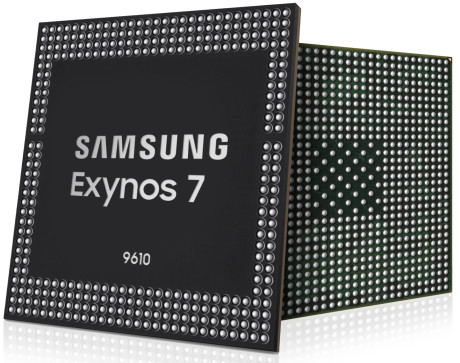Samsung's Exynos 9610 Packs Imaging Smarts and 4K Slow-Mo
Mar 22, 2018, 7:23 AM by Eric M. Zeman

Samsung today announced the Exynos 7 Series 9610 mobile application processor, a chip built using Samsung's 10nm FinFET process that targets high-end smartphones. The octa-core processor has four Cortex A-73 cores at 2.3 GHz and four Cortex A-53 cores at 1.6 GHz. These are paired with ARM's newer Bifrost-based Mali-G72 GPU for gaming. A Cortex-M4F low-power sensing hub handles the constant street of information generated by sensors, gestures, and other inputs without waking the main processor. One of the key advancements of this chip is the addition of a neural network engine for face detection that can recognize faces covered with hats or hair or glasses. The 9610 also has more advanced depth-sensing for bokeh photos, better low-light augmentation, and processes to reduce signal-to-noise ratio in photos and videos. When it comes to other media, the 9610 can handle slow-motion capture and playback at up to 480 frames per second (half that of the Galaxy S9). More interestingly, the revised image signal processor uses a multi-format codec that allows encoding and decoding slow motion at resolutions up to 4K at 120fps. On the connectivity side of things, the 9610 supports Cat 12 LTE with three-channel carrier aggregation for up to 600 Mbps on the downlink and Cat 13 LTE with two-channel carrier aggregation for up to 150 Mbps on the uplink. It also includes 2x2 MIMO WiFi, Bluetooth 5.0, GPS, and an FM radio. Samsung says the Exynos 7 Series 9610 is expected to be mass produced in the second half of this year.
Comments
No messages


 iPhone 16 Brings More Features to All Price Points, Including New Camera Control
iPhone 16 Brings More Features to All Price Points, Including New Camera Control
 Qualcomm Expands Flagship Phone Chip Series
Qualcomm Expands Flagship Phone Chip Series
 Samsung Puts its Best Camera Yet in the Galaxy S23 Ultra
Samsung Puts its Best Camera Yet in the Galaxy S23 Ultra
 Motorola Gets Serious About Foldables with New RAZR Lineup
Motorola Gets Serious About Foldables with New RAZR Lineup
 Qualcomm's New Chip for Entry-Level Phones Moves to 4nm
Qualcomm's New Chip for Entry-Level Phones Moves to 4nm


